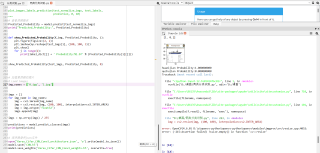问题遇到的现象和发生背景

用代码块功能插入代码,请勿粘贴截图
# 加载要预测的图片
# Load images
img_names = ['0.jpg', '1.jpg']
imgs = []
for img_name in img_names:
img = cv2.imread(img_name)
img = cv2.resize(img, (100, 100), interpolation=cv2.INTER_AREA)
img = img.astype('float32')
imgs.append(img)
imgs = np.array(imgs) / 255
predictions = model.predict_classes(imgs)
print(predictions)
运行结果及报错内容
error: OpenCV(4.6.0) D:\a\opencv-python\opencv-python\opencv\modules\imgproc\src\resize.cpp:4052: error: (-215:Assertion failed) !ssize.empty() in function 'cv::resize'
我的解答思路和尝试过的方法
预测图片目录如图,两个文件夹都有0.jpg和1.jpg 路径也没有中文

我想要达到的结果
请问怎么解决这个报错
下附完整原代码
# -*- coding: utf-8 -*-
"""
第05讲 Keras卷积神经网络识别CIFAR-10图像
CIFAR-10数据集介绍
http://www.cs.toronto.edu/~kriz/cifar.html
"""
# Import Library,数据准备,标准化
import numpy as np
import os
os.environ["TF_KERAS"] = '1'
import tensorflow.compat.v1 as tf
tf.disable_v2_behavior()
import cv2
import tensorflow as tf
from tensorflow.python.keras.utils import np_utils
os.environ['CUDA_VISIBLE_DEVICES'] = '0' # 0代表使用第一块GPU显卡
tf.config.set_soft_device_placement = False # TensorFlow 自动选择一个现有且受支持的设备来运行操作,以避免指定的设备不存在
tf.config.experimental.set_memory_growth = True # 仅在需要时申请显存空间
gpus = tf.config.experimental.list_physical_devices('GPU') # 获取全部的GPU显卡
print("gpus:", gpus)
if gpus:
# gpus[0] 代表设置第一块显卡的配置,代表建立了显存大小为1GB的“虚拟GPU”
tf.config.experimental.set_virtual_device_configuration(gpus[0], [tf.config.experimental.VirtualDeviceConfiguration(memory_limit=4096)])
#logical_gpus = tf.config.experimental.list_logical_devices('GPU')
#print(len(gpus), len(logical_gpus), 'Logical gpus')
# 随机种子
np.random.seed(10)
train_path = r'C:\\train'
# 制作标签字典
label_dict = {i: j for i, j in enumerate(os.listdir(train_path))}
# 制作训练集和测试集
train_imgs = []
train_labels = []
test_imgs = []
test_labels = []
train_normalize_imgs = []
test_normalize_imgs = []
train_num = 50 # 使用训练的图片数量
train_proportion = 0.9 # 训练集和测试集划分的比例
# 获取训练数据和训练标签
for label, path in enumerate(os.listdir(train_path)):
images = os.listdir(os.path.join(train_path, path))
images = images[:train_num]
for index, img in enumerate(images):
print(os.path.join(train_path,path,img))# 读取图片路径
img = cv2.imread(os.path.join(train_path, path, img))
print(img)
img = cv2.resize(img, (100, 100), interpolation=cv2.INTER_AREA)
# 判断训练数量,按训练比例分成训练集和测试集
if index < train_num * train_proportion:
train_labels.append(label)
train_imgs.append(img)
train_normalize_imgs.append(img.astype('float64'))
else:
test_labels.append(label)
test_imgs.append(img)
test_normalize_imgs.append(img.astype('float64'))
# 转换为tensorflow比较好处理的numpy数组
train_imgs = np.array(train_imgs)
train_labels = np.array(train_labels)
test_imgs = np.array(test_imgs)
test_labels = np.array(test_labels)
train_normalize_imgs = np.array(train_normalize_imgs)
test_normalize_imgs = np.array(test_normalize_imgs)
# 输出形状
print("train data:", 'images:', train_imgs.shape, " labels:", train_labels.shape)
print("test data:", 'images:', test_imgs.shape, " labels:", test_labels.shape)
# 转为one-hot编码
from tensorflow.python.keras.utils import np_utils
train_labels_OneHot = tf.keras.utils.to_categorical(train_labels)
test_labels_OneHot = tf.keras.utils.to_categorical(test_labels)
# 建立建立3次卷积神经网络模型
from tensorflow.keras import Sequential
from tensorflow.keras.layers import Conv2D, MaxPooling2D, Flatten, Dropout, Dense
model = Sequential()
# 卷积层1与池化层1
model.add(Conv2D(filters=32, kernel_size=(3, 3), input_shape=(100, 100, 3),
activation='relu', padding='same'))
model.add(Conv2D(filters=32, kernel_size=(3, 3),
activation='relu', padding='same'))
model.add(MaxPooling2D(pool_size=(2, 2)))
# 卷积层2与池化层2
model.add(Conv2D(filters=64, kernel_size=(3, 3),
activation='relu', padding='same'))
model.add(Conv2D(filters=64, kernel_size=(3, 3),
activation='relu', padding='same'))
model.add(MaxPooling2D(pool_size=(2, 2)))
# 卷积层3与池化层3
model.add(Conv2D(filters=128, kernel_size=(3, 3),
activation='relu', padding='same'))
model.add(Conv2D(filters=128, kernel_size=(3, 3),
activation='relu', padding='same'))
model.add(MaxPooling2D(pool_size=(2, 2)))
# 建立神经网络(平坦层、隐藏层、输出层)
model.add(Flatten())
model.add(Dropout(0.15))
model.add(Dense(1000, activation='relu'))
model.add(Dropout(0.15))
model.add(Dense(500, activation='relu'))
model.add(Dropout(0.15))
model.add(Dense(2, activation='softmax'))
# 输出模型列表,需要调整近1000万的参数
print(model.summary())
# 训练模型
epochs = 1 # 训练次数
model.compile(loss='categorical_crossentropy', optimizer='adam',
metrics=['acc'])
train_history = model.fit(train_normalize_imgs, train_labels_OneHot,
validation_split=0.0005,shuffle=True,
epochs=epochs, batch_size=256)
# 评估模型的准确率
import matplotlib.pyplot as plt
def show_train_history(train_history, train_acc, test_acc):
plt.plot(train_history.history[train_acc])
plt.plot(train_history.history[test_acc])
plt.title('Train History')
plt.ylabel('Accuracy')
plt.xlabel('Epoch')
plt.legend(['train', 'test'], loc='upper left')
plt.show()
print("H.histroy keys:", train_history.history.keys())
show_train_history(train_history, 'acc', 'val_acc')
show_train_history(train_history, 'loss', 'val_loss')
scores = model.evaluate(test_normalize_imgs,
test_labels_OneHot, verbose=0)
print("scores:", scores)
# 进行预测
prediction = model.predict_classes(test_normalize_imgs)
from collections import Counter
result = Counter(prediction[1000:])
print('cat 识别数量:' , result)
result = Counter(prediction[1000:])
print('dog 识别数量:' , result)
"""
def plot_images_labels_prediction(images, labels, prediction,
idx, num=10):
fig = plt.gcf()
fig.set_size_inches(12, 14)
if num > 25: num = 25
for i in range(0, num):
ax = plt.subplot(5, 5, 1 + i)
ax.imshow(images[idx], cmap='binary')
title = str(i) + ',' + label_dict[labels[i]]
if len(prediction) > 0:
title += '=>' + label_dict[prediction[i]]
ax.set_title(title, fontsize=10)
ax.set_xticks([]);
ax.set_yticks([])
idx += 1
plt.show()
plot_images_labels_prediction(test_normalize_imgs, test_labels,
prediction, 0, 10)
"""
# 查看预测概率
Predicted_Probability = model.predict(test_normalize_imgs)
print("Predicted_Probability:", Predicted_Probability)
def show_Predicted_Probability(X_img, Predicted_Probability, i):
plt.figure(figsize=(2, 2))
plt.imshow(np.reshape(test_imgs[i], (100, 100, 3)))
plt.show()
for j in range(2):
print(label_dict[j] + ' Probability:%1.9f' % (Predicted_Probability[i][j]))
show_Predicted_Probability(test_imgs, Predicted_Probability, 0)
# 加载要预测的图片
# Load images
img_names = ['0.jpg', '1.jpg']
imgs = []
for img_name in img_names:
img = cv2.imread(img_name)
img = cv2.resize(img, (100, 100), interpolation=cv2.INTER_AREA)
img = img.astype('float32')
imgs.append(img)
imgs = np.array(imgs) / 255
predictions = model.predict_classes(imgs)
print(predictions)
# 保存模型和json文件
open('Keras_Cifar_CNN_Conv3_architecture.json', 'w').write(model.to_json())
model.save('CNN.h5')
model.save_weights('Keras_Cifar_CNN_Conv3_weights.h5', overwrite=True)

